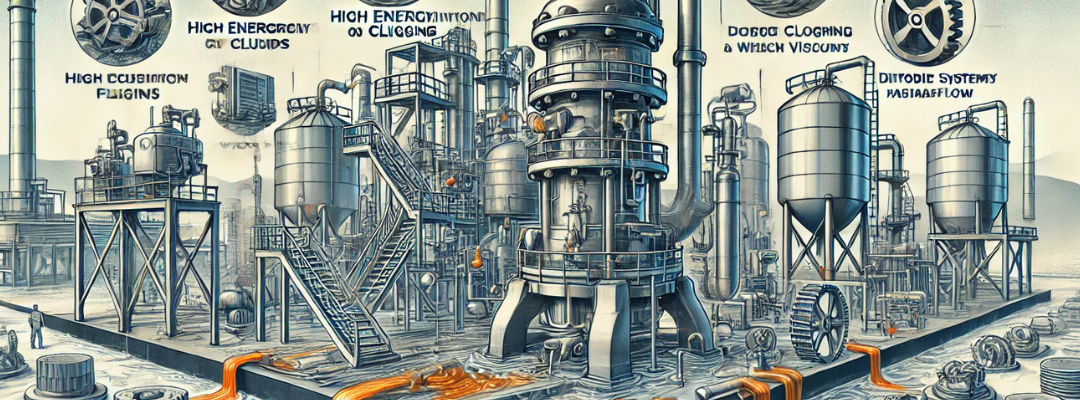Pumping viscous fluids is a critical yet challenging task in the chemical industry. The thick and resistant nature of these fluids leads to flow resistance, pump wear, energy inefficiency, and cavitation risks. Furthermore, many viscous fluids exhibit non-Newtonian behavior, where their viscosity varies under shear stress, complicating the pumping process.
However, by selecting the right pumping technology, optimizing system design, and implementing advanced engineering solutions, these challenges can be effectively mitigated. This article explores the key obstacles and the best solutions for handling viscous fluids efficiently.
Key Challenges & Advanced Solutions for Pumping Viscous Fluids
1. High Energy Consumption
Challenge:
Viscous fluids require more energy to pump due to their resistance to flow, leading to higher operational costs and increased mechanical strain on pumps.
Solution:
Positive Displacement Pumps (PDPs):
Gear pumps, progressive cavity pumps, and peristaltic pumps maintain a steady fluid volume per cycle, ensuring efficiency with high-viscosity fluids.
Variable Frequency Drives (VFDs):
VFDs optimize motor speed based on flow demand, reducing power consumption and wear over time.
Heated Pumping Systems:
For temperature-sensitive fluids, heating elements can reduce viscosity, lowering energy demands
2. Pump Wear and Component Fatigue
Challenge:
The thick, abrasive nature of many viscous fluids leads to rapid deterioration of pump components like seals, impellers, and bearings.
Solution:
Wear-Resistant Materials:
Use pumps made from stainless steel, PTFE-coated components, or ceramic linings to resist corrosion and wear.
Seal-Free Designs:
Magnetic drive pumps and diaphragm pumps eliminate mechanical seals, minimizing maintenance costs.
Low RPM Operation:
Running pumps at lower speeds extends the life of moving parts while maintaining efficient performance.
3. Cavitation and Suction Limitations
Challenge:
Viscous fluids often have low Net Positive Suction Head (NPSH), making them prone to cavitation, which can damage pump internals.
Solution:
Low-NPSH Positive Displacement Pumps:
Lobe pumps and progressive cavity pumps operate efficiently even in low-pressure conditions.
Optimized Suction Line Design:
Increase suction pipe diameter and reduce bends to maintain smooth flow and prevent air pockets
Pump Priming Enhancements:
Use self-priming pumps or install priming chambers to remove entrapped air before operation.
4. Temperature Variability & Viscosity Changes
Challenge:
Many viscous fluids become too thick at low temperatures or too thin at high temperatures, affecting flow consistency.
Solution:
Heated Jackets for Pumps and Piping:
- Maintain fluids at optimal temperatures with heat-traced pipelines.
Thermal Control Systems:
- Use real-time temperature sensors to adjust heating or cooling mechanisms dynamically.
Low-Shear Pumping Technologies:
- Peristaltic pumps and diaphragm pumps minimize shear forces, preserving fluid integrity.
5. Shear Sensitivity in High-Viscosity Fluids
Challenge:
Many viscous substances like polymers, gels, and emulsions are shear-sensitive, meaning excessive shear stress can degrade the product.
Solution:
Low-Shear Pumping Mechanisms:
- Lobe pumps, peristaltic pumps, and diaphragm pumps move fluids gently, avoiding structural damage.
Diaphragm Pumps for Sensitive Fluids:
- Excellent for delicate chemical solutions, ensuring minimal product degradation.
6. Difficulty in Priming Viscous Fluids
Challenge:
High-viscosity fluids struggle to self-prime, leading to delayed start-up times, inconsistent flow, and increased pump failures.
Solution:
Self-Priming Pumps:
Peristaltic and diaphragm pumps eliminate the need for external priming mechanisms.
Flooded Suction Configuration:
- Positioning the pump below the fluid reservoir ensures gravity-driven priming.
7. Pressure Drop in Piping Systems
Challenge:
Long pipelines, multiple bends, and fittings increase pressure loss, reducing overall pump efficiency.
Solution:
Larger Diameter Piping:
Increases flow capacity, reducing pressure losses.
Streamlined Pipe Layout:
- Minimizes bends, elbows, and sharp turns to enhance flow efficiency.
Booster Pumps:
- Maintain consistent flow and pressure in extended pipelines.
8. Precise Flow Control & Dosing Accuracy
Challenge:
Achieving precise dosing and flow control is difficult due to viscosity fluctuations and varying resistance.
Solution:
Positive Displacement Pumps:
- Ensure accurate and repeatable flow rates for dosing applications.
Real-Time Flow Sensors & Smart Automation:
- Automated flow meters detect and adjust pump performance to maintain precision.
Recommended Pump Types for Viscous Fluids
| Pump Type | Best for |
| Gear Pumps | High-viscosity oils, resins, and adhesives |
| Peristaltic Pumps | Shear-sensitive, abrasive, and highly viscous fluids |
| Progressive Cavity Pumps | Slurries, polymers, and pastes with solids |
| Lobe Pumps | Viscous emulsions, creams, and food-grade chemicals |
| Diaphragm Pumps | Corrosive, abrasive, or self-priming fluid handling |

